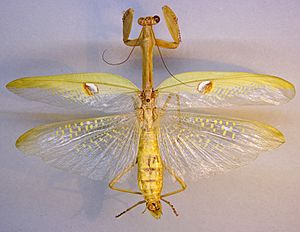Stagmatoptera biocellata facts for kids
Quick facts for kids Stagmatoptera biocellata |
|
|---|---|
 |
|
| From Zoologische Staatssammlung München | |
| Scientific classification |
Stagmatoptera biocellata is a fascinating type of praying mantis. It belongs to the species of insects in the family Mantidae. This amazing creature was first described in 1869 by a scientist named Saussure.
Contents
What is a Praying Mantis?
Praying mantises are cool insects known for their unique look. They have long bodies and two large, triangular heads. Their front legs are very strong and are held in a way that looks like they are praying. This is how they got their name!
Where Do Mantises Live?
Mantises live all over the world, especially in warmer areas. You can find them in forests, grasslands, and even gardens. They like places where they can hide among plants and catch other insects.
What Do Mantises Eat?
Praying mantises are expert hunters. They mainly eat other insects like flies, crickets, and moths. They wait patiently, perfectly still, until an unsuspecting insect comes close. Then, they quickly snatch their prey with their spiky front legs.
How They Hunt
Mantises are masters of camouflage. This means they blend in with their surroundings, like leaves or branches. This helps them surprise their prey. They are very quick and precise when they catch their food.
Life Cycle of a Mantis
The life cycle of a praying mantis is quite interesting. It starts from an egg and goes through several stages.
Egg Stage
Female mantises lay their eggs in a special case called an ootheca. This ootheca is a foamy, protective covering that hardens over time. It keeps the eggs safe from bad weather and predators. The ootheca is often attached to a branch or a wall.
Nymph Stage
When the eggs hatch, tiny baby mantises, called nymphs, emerge. These nymphs look like smaller versions of adult mantises. They are very vulnerable at this stage and must find food quickly.
Growing Up
As nymphs grow, they shed their skin several times. This process is called molting. Each time they molt, they get a little bigger and their wings develop more. This continues until they reach their full adult size.
Adult Stage
Once a mantis becomes an adult, it is ready to mate and lay eggs. Adult mantises have fully developed wings, though not all species can fly well. Their main goal is to reproduce and continue the life cycle.
Interesting Facts About Mantises
- Mantises can turn their heads almost 360 degrees. This helps them see all around without moving their bodies.
- Some larger mantis species can even catch small lizards, frogs, or birds!
- They are often considered good insects to have in gardens because they eat pests.
- There are over 2,400 different species of praying mantises around the world.
See also
 In Spanish: Stagmatoptera biocellata para niños
In Spanish: Stagmatoptera biocellata para niños
- List of mantis genera and species

